Republic of Ireland
1922-1939
The Football Association of Ireland was formed in September 1921 by members of the Football League of Ireland, which had broken away from the established Irish League the previous June. The refusal of the Irish FA to allow the replay of the Irish Cup final between Glenavon and Shelbourne to be played in Dublin because of the security situation (the Irish Civil War was still underway at the time) was the final straw for the southern clubs, who thought the Unionist dominated Irish FA neglected their interests. Association football had few adherents outside Dublin and Belfast and was widely referred to as the "garrison game" because it was played by the British Army. Meanwhile the Gaelic Athletic Association banned its members from playing or even watching association football.
With the partition of Ireland in 1922, the FA of Ireland became the FA of the Irish Free State (FAIFS). Although the new association was boycotted by the four British associations, it was admitted to FIFA in 1923. A Free State football team competed in the 1924 Paris Olympics under the auspices of the Irish Olympic Committee. The Olympic team then played the United States in the first football international to be held on Free State soil. It was not until March 1926 that a national team organised by the FAIFS played an international fixture.
Home games were usually played at Dalymount Park in north Dublin, the home of Bohemians FC, which was capable of holding 40,000.
Sources:
 Irish Free State 1922-1926
Irish Free State 1922-1926
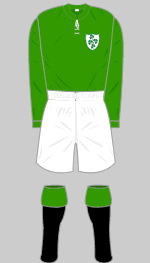
1924 Olympics Team
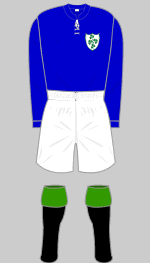
1924 Olympics Change
v Bulgaria
Designer:
Immediately after the split with the Belfast-based Irish FA, the British Football Associations agreed to boycott the FA of Ireland and it was not until after the Second World War that a team from the Republic would meet one of the "home nations."
Following the formation of the Irish Free State in 1922, the FAI was renamed as the Football Association of the Irish Free State (FAIFS). The team that played in the 1924 Paris Olympics (and entertained the touring United States team immediately afterwards) was organised by the Irish Olympics Committee rather than the FAIFS and was not supported by the government of the fledgling Free State. According to a recent article (20 December 2010) in the Irish Tribune, the team played in St Patrick's blue in their opening game against Bulgaria (who wore green).
 Irish Free State 1926-1929
Irish Free State 1926-1929
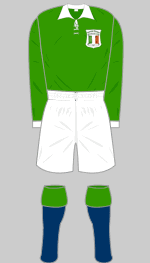
1926-1929
Designer:
The boycott by the British Associations had little effect once FIFA recognised the FAIFS' right to represent the interests of association football in the Free State. In March 1926 the FAIFS organised a team to travel to Turin to meet Italy in what is now considered their first international fixture, a match which they lost 0-3. In 1934 the Free State entered the World Cup qualifying competition for the first time. A change kit was not required during this period. The crest worn during this period featured the Irish tricolour on a shield with embroidered scrollwork.
 Irish Free State 1930-1936
Irish Free State 1930-1936
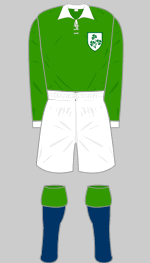
1930-1936
Designer:
For the World Cup qualifier against Belgium in Febrary 1930, the familar shamrock crest first worn by the 1924 Olympics side, replaced the tricolour crest. The Irish Football Association team adopted an almost identical crest in 1931.
 Ireland 1937-1939
Ireland 1937-1939
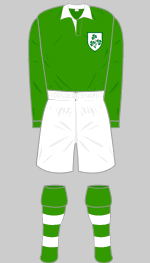
1937-1939
Designer:
In 1937 southern Ireland severed all links with the United Kingdom and became a republic. The national team was referred to as Éire in the Irish language but since English was the international lingua franca in those days, they were more commonly referred to as Ireland. Both the Irish FA and the FA of Ireland (formerly the FAIFS) claimed to represent association football throughout the island of Ireland and selected players from both sides of the border. There were in effect two national teams, both calling themselves Ireland and at least 38 players played for both teams between 1937 and 1950.
Ireland remained neutral during World War Two but no international fixtures were possible during what was known in the Republic as "The Emergency."
<Ireland 1882-1921 : Home Internationals Index :
Ireland 1946-1959>


 Irish Free State 1926-1929
Irish Free State 1926-1929
 Irish Free State 1930-1936
Irish Free State 1930-1936
